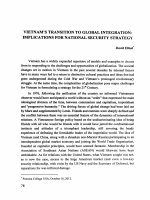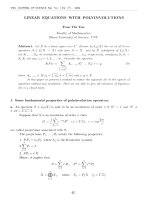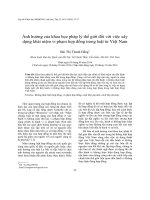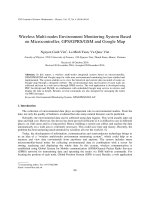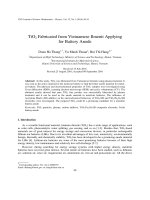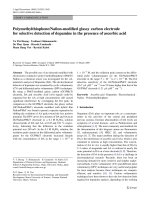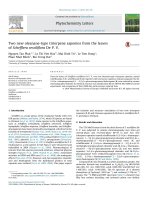DSpace at VNU: Capillary electrochromatography with contactless conductivity detection for the determination of some inorganic and organic cations using monolithic octadecylsilica columns
Bạn đang xem bản rút gọn của tài liệu. Xem và tải ngay bản đầy đủ của tài liệu tại đây (452.08 KB, 6 trang )
Analytica Chimica Acta 653 (2009) 228–233
Contents lists available at ScienceDirect
Analytica Chimica Acta
journal homepage: www.elsevier.com/locate/aca
Capillary electrochromatography with contactless conductivity detection for the
determination of some inorganic and organic cations using monolithic
octadecylsilica columns
Thanh Duc Mai a,b , Hung Viet Pham a , Peter C. Hauser b,∗
a
b
Centre for Environmental Technology and Sustainable Development (CETASD), Hanoi University of Science, Nguyen Trai Street 334, Hanoi, Viet Nam
University of Basel, Department of Chemistry, Spitalstrasse 51, 4056 Basel, Switzerland
a r t i c l e
i n f o
Article history:
Received 11 May 2009
Received in revised form 19 August 2009
Accepted 8 September 2009
Available online 11 September 2009
Keywords:
Capacitively coupled contactless
conductivity detection
Capillary electrochromatography
Inorganic cations
Amines
Amino acids
a b s t r a c t
A fast separation of alkali and alkaline earth metal cations and ammonium was carried out by capillary electrochromatography on monolithic octadecylsilica columns of 15 cm length and 100 m inner
diameter using water/methanol mixtures containing acetic acid as mobile phase. On-column contactless conductivity detection was used for quantification of these non-UV-absorbing species. The method
was also extended successfully to the determination of small amines as well as of amino acids, and the
separation selectivity was optimized by varying the composition of the mobile phase. Detection limits
of about 1 M were possible for the inorganic cations as well as for the small amines, while the amino
acids could be quantified down to about 10 M. The separation of 12 amino acids was achieved in the
relatively short time of 10 min.
© 2009 Elsevier B.V. All rights reserved.
1. Introduction
Capillary electrochromatography (CEC) as a hybrid technique
combines some of the features of capillary electrophoresis (CE) and
of liquid chromatography (LC). Both separation mechanisms occur
concurrently, and this feature may be employed to achieve selectivities otherwise difficult to obtain. Transport of the analyte is due to
electroosmotic and electrokinetic mobility, thus a flat flow profile
is obtained, and band broadening is reduced compared to chromatography. A further advantage is the much lower instrumental
complexity as high voltage power supplies are much simpler, and
less expensive, than high pressure pumps. Since electrochromatography has to be carried out in columns of limited diameter, the
amount of consumables (solvent) is also greatly reduced.
CEC may be carried out in capillaries filled with packing material as used in chromatographic columns. However, this requires
the employment of frits, and this approach has been fraught with
problems [1,2]. Open-tubular electrochromatography (OT-CEC), in
which the stationary phase is coated on the inner wall of the capillary, overcomes these problems. However, due to the single layer
of stationary phase, the capacity of OT-CEC is low, which adversely
affects detection and this method has therefore seen limited use
∗ Corresponding author. Fax: +41 61 267 1013.
E-mail address: (P.C. Hauser).
0003-2670/$ – see front matter © 2009 Elsevier B.V. All rights reserved.
doi:10.1016/j.aca.2009.09.014
[2,3]. The third option is to use monolithic columns. As the continuous structure is anchored to the capillary wall, retaining frits are not
needed, the high porosity affords high chromatographic efficiency
and allows a higher sample loading. This technique thus overcomes
the disadvantages of packed-column CEC and of OT-CEC. The surface of the stationary phase may be modified to create tailored sites
for interaction and desired charged moieties for the generation of
electroosmotic flow.
Detection in CEC is usually achieved by UV-absorbance measurement. However, this method is not suited for all species. For CE
capacitively coupled contactless conductivity detection (C4 D) has
been gaining popularity in recent years [4] as it allows the determination of any charged species. The contactless approach is possible
as external electrodes form an electrical capacitance with the internal electrolyte solution. This allows the coupling of an ac-voltage
into and out of the detector cell. Details on the fundamental principles can be found for example in these publications [5–8] and
several recent reviews are available [4,9–12]. Applications of C4 D
have not been restricted to detection in CE, but have also been
extended to the separation methods of ion chromatography [13]
and HPLC [14–16] as well as to flow-injection analysis [17,18].
Applications of C4 D in CEC in general have been very limited
to date. Hilder et al. communicated the determination of several
inorganic anions using a column packed with a particulate ionexchange material as stationary phase [19]. Detection was carried
ˇ et al. gave an account of the
out directly on the column. Kubán
T.D. Mai et al. / Analytica Chimica Acta 653 (2009) 228–233
determination of inorganic cations by OT-CEC using an anionic
polymer wall-coating as stationary phase [20]. To our knowledge,
the application of C4 D to CEC employing a monolithic stationary
phase has not yet been reported.
2. Materials and methods
2.1. Chemicals and materials
Tetramethylorthosilicate (TMSO), poly(ethylene glycol) (PEG,
Mw = 10,000), urea, diethylamine, dimethyloctadecylchlorosilane
and methanol were purchased from Fluka (Buchs, Switzerland)
and were of puriss grade. 2-Amino-1-butanol, 1-amino-2-propanol
were obtained from Lancaster (Eastgate, White Lund, Morecambe,
England). 1-Phenyl-ethylamine was purchased from Fluka and of
analytical grade. 1,2-Dimethylpropylamine was purchased from
Sigma–Aldrich (Buchs, Switzerland). Toluene was from TCI (Zwijndrecht, Belgium). The chemicals for the preparation of background
electrolytes (BGE), and the amino acids were of analytical grade
and purchased from Fluka. Fused-silica capillaries (100 m inner,
365 m outer diameter) were purchased from BGB Analytik AG
(Boeckten, Switzerland). The commercial monolithic capillary column, RP-18, end-capped, with a length of 150 mm, an inner
diameter of 100 m, and an outer diameter of 365 m, was purchased from Merck (Dietikon, Switzerland). All stock and BGE
solutions were prepared with deionised water with a resistivity
higher than 18 M cm. The stock solutions of inorganic cations
(5 mM) were prepared from their corresponding chloride salts
(Merck, analytical grade). All standard solutions were prepared
by diluting the stock solutions to the desired concentrations with
the separation buffer. All solutions were filtered through 0.2 m
PTFE membrane filters (Chromafil O-20/15 MS, Macherey-Nagel,
Oensingen, Switzerland), and degassed in an ultrasonic bath for
5 min before injection into the capillary.
2.2. Instrumentation
2.2.1. Preparation of self-made monolithic octadecylsilica
capillaries
The preparation of monolithic silica gel for capillary HPLC and
the factors affecting this process were described exhaustively by
Ishizuka et al. [21,22], Guiochon [23] and Nakanishi et al. [24]. The
coating process of octadecyl groups (C18) onto the monolithic silica
layer was also described previously by Tanaka et al. [25] and Yang et
al. [26]. Accordingly, the preparation procedure was carried out as
follows: tetramethoxysilane (TMSO, 0.8 mL) was added into a solution of poly(ethylene glycol) (PEG, Mw = 10,000, 0.176 g) and urea
(0.18 g) in 2 mL acetic acid (0.01 M). The mixture was stirred at 0 ◦ C
for 40 min until a homogeneous solution was obtained. This solution was then pumped through a fused-silica capillary tube (i.d. of
100 m and length of 120 cm) that had already been treated with
1 M NaOH solution for 3 h at 40 ◦ C, and allowed to “age” at 40 ◦ C
for 24 h. The monolithic silica column formed was put into an oven
at 120 ◦ C for 3 h and then rinsed with water and methanol subsequently. The column was dried by flushing with nitrogen and left
in an oven at 70 ◦ C for 3 h. After drying, heat-treatment was carried out at 330 ◦ C for 24 h, followed by a rinse with water and then
methanol.
The column produced was then cut into 3 smaller pieces
of 40 cm length due to the high backpressure when pumping
octadecyldimethyl-N,N-diethylaminosilane (ODS-DEA) solution
through a long monolithic capillary. The solution of ODS-DEA was
prepared by placing 1 g octadecyldimethylchlorosilane (ODS-Cl)
into a mixture of 1 mL diethylamine and 4 mL toluene, followed by
stirring continuously at 50 ◦ C for 1 h. The mixture was then passed
229
through a PTFE 0.2 m membrane filter to obtain a clear solution of
ODS-DEA. ODS-DEA was pumped through a 40 cm long monolithic
silica capillary for 3 h at 60 ◦ C. The column was then washed again
with methanol and then with water. Both ends of the final capillaries were removed (5 cm at each end), and the remainder cut into 2
columns with a length of 15 cm each.
2.2.2. CEC-C4 D system
A purpose-built CE-C4 D system was used for column checking
and all separations. This instrument is based on a high voltage
power supply with interchangeable polarity (CZE 1000R) from
Spellman (Pulborough, UK). The capacitively coupled contactless
conductivity detector used was built in-house, and is based on
two tubular electrodes of 4 mm length which are separated by a
gap of 1 mm and a Faradaic shield. Details on this detector can be
found elsewhere [27–29]. The resulting signal was recorded with
a MacLab/4e data acquisition system (AD Instruments, Castle Hill,
Australia).
The columns were mounted horizontally on a perspex sheet
together with the detector cell and the containers at the two ends
which hold the electrodes for application of the high voltage. The
cell was mounted 1 cm from the capillary end. In other words, the
effective and total lengths for capillaries used were 14 and 15 cm,
respectively. For safety, the assembly was placed into a perspex
cage, which was fitted with a microswitch to interrupt the high
voltage on opening. A voltage of +5 kV was applied for all separations. Standards were injected electrokinetically using a voltage
of +1.5 kV for 3 s after stability of the baseline had been ascertained.
3. Results and discussion
3.1. Quality evaluation of the self-made capillary with C4 D
After a preliminary check with a microscope, the longitudinal
homogeneity of the self-made monolithic capillary was compared
with that of an open capillary and the commercial capillary column, using C4 D, for further quality assessment. The technique had
been used previously for checking the homogeneity of the coating applied to a commercial monolithic column [30], and of the
uniformity of a packed column [31]. The columns were filled with
an aqueous electrolyte solution of 20 mM CH3 COOH and conditioned by applying a high voltage of 5 kV until a stable current was
observed. This took about 5 min. The capillaries were then moved
through the detector and the magnitude of the output signal of the
contactless conductivity detector was recorded every 5 mm along
the length. The magnitude of this signal is a measure for the total
ionic conductivity between the electrodes which not only depends
on the concentration of the ions, but also on the fraction of the
volume taken up by the ion bearing solution. For a dry capillary
the signal is negligible. The amplitude of the signal therefore gives
an indication of the density of the monolithic structures and the
approach is thus a facile method to evaluate the porosity of the
columns. The results obtained are shown in Fig. 1. Two important
conclusions can be drawn from the data. Firstly, it is seen in the figure, that for both monolithic columns the signal is clearly reduced
compared to the open capillary, but that the porosity of the commercial column is slightly lower (appr. 76%) than that of the column
made in-house (appr. 85%) as the conductivity signal is lower for
the former. Secondly, the signal variation along the axis allows conclusions regarding the longitudinal homogeneity of the monolithic
structures as the columns were filled with a solution of even ionic
concentration. Clearly, the consistency of the in-house made column is not quite as good as that of the commercial one as indicated
by the variation in the signal amplitude along the capillary, but
230
T.D. Mai et al. / Analytica Chimica Acta 653 (2009) 228–233
Fig. 1. Homogeneity comparison between the C18-silica monolithic column made
in-house (- -), commercial monolithic column (- -) and open-tubular (-᭹-) capillary. Electrolyte inside the capillaries: 20 mM CH3 COOH in water.
these fluctuations are within a few percent and not considered
significant.
3.2. Determination of some inorganic cations
The selection of the mobile phase for CEC with conductivity
detection is critical as the requirements for electrophoresis and
for the ion pair chromatographic process have to be satisfied as
well as those for conductivity detection. It must be compatible
with the stationary phase, have adequate elution strength and
be of low specific conductance in order to allow high sensitivity in conductometric detection and to minimize Joule heating.
Note, that conductometric detection is more sensitive to heating effects than other detection methods because of the relatively
high temperature coefficient of ionic conductivity. Several buffer
systems frequently used for HPLC were briefly tested, namely
water/methanol mixtures containing trifluoro-acetic acid, phosphate buffers, tris(hydroxymethyl)aminomethane, hydrochloric
acid, citric acid and formic acid, but these were all found not to give
stable baselines, presumably in the majority of cases due to Joule
heating caused by too high a conductivity. A buffer based on 2-(Nmorpholino)ethanesulfonic acid and histidine (MES/His), which is
widely used in CE with conductivity detection, was also found to
be problematic as it tended to cause blockage of the monolithic
column. This is thought to be caused by precipitation of histidine
occurring on evaporation of the solvent mixture at the ends of the
columns during the inevitable periods when they need to be handled outside of the buffer containers. A mobile phase consisting of
acetic acid in a water/methanol mixture was observed to generally
give more stable baselines. The optimization for the separation of
inorganic cations thus consisted of finding the best concentration
of acetic acid in an appropriate ratio of methanol to water. However, it was still found necessary to carefully control the applied
voltage as evidenced by Ohm’s plot studies. The voltage applied to
the 15 cm long columns when using acetic acid based electrolyte
solutions had to be restricted to a maximum of about 5 kV in order
to prevent instability due to thermal effects, but the exact limit
depended on the buffer composition.
The proportion of methanol in the mobile phase was found
to strongly affect the retention time of the analytes. As seen in
Fig. 2, for separations carried out on the monolithic C18-column
made in-house, the analytes are more strongly retained for the
higher percentages of methanol, and therefore also the separation
is improved. However, the peak areas were also found to be dependent on the methanol content. Note, that the first separation shown
in the figure was carried out with only half the concentrations of the
cations of the subsequent runs. For the highest methanol content
in the mobile phase, the peaks even practically disappeared as seen
in electropherogram (d). The change in conductivity for the analyte
peaks is governed by the Kohlrausch regulating function (which in
turn is dependent on the mobility of all ionic species involved) as
well as the degree of dissociation of acetic acid, and therefore not
intuitively predictable for the partly aqueous medium. At a fixed
concentration of acetic acid, when the proportion of methanol is
increased, the degree of dissociation of acetic acid is decreased. This
must be responsible for the change in peak area, but also leads to a
reduction of background conductivity as evidenced by the decrease
in current through the capillary from 3 to 0.4 A for the change
of methanol content from 20 to 70%. The baseline drift in electropherogram 2(a) illustrates the effect of excessive Joule heating on
detection caused by too high a background conductivity. This is
due to the higher susceptibility of C4 D to thermal drifts compared
to other methods of detection. The experimental data of Fig. 2 indicates that a high fraction of methanol is not favourable for detection
without adjusting the concentration of acetic acid.
A further investigation was thus carried out by varying the
concentration of acetic acid for different proportions of methanol.
Three electropherograms obtained for 40, 50 and 60% methanol
which represent the optimum concentrations of acetic acid for
these methanol levels in terms of separation are shown in Fig. 3.
Note that Fig. 3(a) is identical to Fig. 2(b) but is reproduced here to
facilitate a direct comparison in terms of migration times and peak
separation. It is evident, that all tested cations, including NH4 + and
K+ , can be well separated using a mobile phase consisting of 40 mM
acetic acid in a 50% (v/v) methanol/water-mixture. However, the
sensitivity is not at the maximum for these conditions. For simple
samples with few of the ions present, different conditions which
give higher sensitivity, or faster analysis times, may be suitable.
A further investigation of the column made in-house is documented in Fig. 4. For comparison, the separation was carried out
by electrophoresis alone, in an open capillary with the identical
length of 15 cm, and by equally applying a voltage of 5 kV. As shown
in Fig. 4(a), the separation in an aqueous background electrolyte
by electrophoresis alone under these conditions is inadequate,
as almost complete overlaps of the peaks for the NH4 + /K+ and
Na+ /Mg2+ pairs was found. When carrying out the electrophoretic
separation in the same partly methanolic acetic acid solution as
used for the CEC experiment, see electropherogram 4(b), the peaks
are found to be delayed compared to the purely aqueous solution,
presumably due to a reduction of the electroosmotic flow, but again
the separation is only partial.
Fig. 2. Influence of the concentration of CH3 OH in the background electrolyte
solution containing 20 mM CH3 COOH on the separation of inorganic cations.
Capillary: self-made C18-silica monolithic column (15 cm total length, 14 cm to
detector × 100 m i.d.); separation voltage: 5 kV; electrokinetic injection: 3 s/1.5 kV.
(a) 20% (v/v) CH3 OH, 50 M cations, V = 5 kV, I = 3.0 A. (b) 40% (v/v) CH3 OH, 100 M
cations, V = 5 kV, I = 1.5 A. (c) 60% (v/v) CH3 OH, 100 M cations, V = 5 kV, I = 0.7 A.
(d) 70% (v/v) CH3 OH, 100 M cations, V = 5 kV, I = 0.4 A.
T.D. Mai et al. / Analytica Chimica Acta 653 (2009) 228–233
231
Table 1
Performance parameters for determination of amines with the commercial column.
Methylamine
Dimethylamine
Trimethylamine
Diethylamine
1-Amino-2-propanol
1,2-Dimethyl-propylamine
2-Amino-1-butanol
1-Phenyl-ethylamine
a
b
c
Calibration rangea (M)
Correlation coefficient r
LODb (M)
Reproducibility peak areac
%RSD
Reproducibility retention
timec %RSD
5–100
5–100
10–100
5–100
5–100
5–100
5–100
5–100
0.9996
0.9989
0.9992
0.9991
0.9979
0.9975
0.9992
0.9987
1.5
2.5
3.0
2.5
1.0
2.0
1.0
1.5
1.4
2.9
2.8
4.0
3.4
4.6
2.4
1.9
0.46
0.44
0.67
0.30
0.47
0.26
0.24
0.61
5 concentrations.
Based on peak heights corresponding to 3 times the baseline noise.
Intra-day, n = 3.
The remaining two traces of Fig. 4 represent a comparison of
the CEC separation of the 6 cations on the two different monolithic
columns available. It was found that the two separation columns
behaved quite differently, even though they were both monolithic
C18-columns of identical length. Part of the reason must be the differences in the monolithic structures (density and homogeneity) as
documented in Fig. 1. It can also be assumed that the density of the
C18-coating on the monoliths differed. An independent optimization of the buffer composition was carried out for the commercial
column as described above, and the two traces of Fig. 4(c) and (d)
represent CEC separations for conditions individually optimized
for best separation on the purpose made and commercial columns
respectively. Complete baseline separation was possible by CEC for
the 6 cations tested for the column made in-house, while for the
commercial column a partial overlap between Ca2+ and Na+ could
not be completely resolved even for the best conditions. Nevertheless, the results clearly indicate the potential of monolithic CEC with
C4 D for achieving fast separations which are not possible by electrophoresis alone (compare electropherograms 4(a) and (b)) under
similar conditions.
Quantitative data was acquired for the self-made column using
the buffer consisting of 40 mM acetic acid in 50% (v/v) methanol in
water. Calibration curves were determined in the range from 5 to
50 M for NH4 + and K+ , from 5 to 100 M for Na+ and Ca2+ and from
2 to 100 M for Mg2+ and Li+ . Linear correlation coefficients, r, from
0.9975 to 0.9991 were obtained. Limits of detection (LODs), based
on peak heights corresponding to 3 times the baseline noise, were
determined for two of the ions, namely Mg2+ and Li+ and found
Fig. 3. Separation of inorganic cations (100 M) at different concentrations of acetic
acid and methanol. (a) 20 mM CH3 COOH, 40% (v/v) CH3 OH. (b) 40 mM CH3 COOH,
50% (v/v) CH3 OH. (c) 80 mM CH3 COOH, 60% (v/v) CH3 OH. Other conditions as for
Fig. 2.
to be 0.5 and 1 M, respectively. These values are close to results
obtained with a similar detector in CE using open tubings [28].
3.3. Determination of small amines
Preliminary trials on the use of CEC-C4 D for the determination of
organic ions were carried out using the mobile phase employed for
the inorganic cations with methyl-, dimethyl- and trimethylamine
as model substances. These species are present in protonated
form under the conditions used, and separation and detection
were successful for both columns. A more thorough investigation was thus conducted by including 1-amino-2-propanol,
2-amino-1-butanol, 1,2-dimethylpropylamine, diethylamine, and
1-phenyl-ethylamine in the standard mixture. The compounds are
often used as intermediates in the synthesis of pharmaceutical
drugs. In order to achieve best separation of the 8 species, an optimization of the composition of the mobile phase was again carried
out systematically by adjusting the methanol to water ratio and
the level of acetic acid as discussed above for the inorganic cations.
The results for optimized conditions are illustrated in Fig. 5. As can
be seen, the majority of the compounds can be separated rapidly
with both columns. However, complete baseline separation of all
ions, namely the distinction between 1,2-dimethylpropylamine
and 2-amino-1-butanol, can again only be achieved with one of the
monoliths, the commercial column in this case. Note, that again the
optimized conditions differ for the two columns. Calibration data
Fig. 4. Separation of inorganic cations by CE and CEC, using (a) an open-tubular capillary of 15 cm length and 40 mM CH3 COOH in water, (b) an open-tubular capillary of
15 cm length and 40 mM CH3 COOH in 50% (v/v) CH3 OH, (c) the self-made C18-silica
monolithic column of 15 cm length and 40 mM CH3 COOH in 50% (v/v) CH3 OH, (d)
commercial monolithic column of 15 cm length and 80 mM CH3 COOH in 55% (v/v)
CH3 OH. Other conditions as for Fig. 2.
232
T.D. Mai et al. / Analytica Chimica Acta 653 (2009) 228–233
Table 2
Performance parameters for determination of amino acids with the commercial column.
Calibration rangea (M)
Lysine (Lys)
Arginine (Arg)
Histidine (His)
Glycine (Gly)
Alanine (Ala)
Valine (Val)
Leucine (Leu)
Serine (Ser)
Threonine (Thr)
Phenylalanine (Phe)
a
b
c
40–500
40–500
40–500
62.5–500
62.5–500
62.5–500
62.5–500
62.5–500
62.5–500
62.5–500
Correlation coefficient r
LODb (M)
Reproducibility peak areac
%RSD
Reproducibility retention
timec %RSD
0.9954
0.9988
0.9975
0.9973
0.9941
0.9966
0.9987
0.9988
0.9916
0.9985
7.5
7.5
7.5
10
10
15
10
15
15
20
3.0
2.9
2.6
2.9
2.7
2.3
2.6
5.4
5.0
5.6
0.24
0.22
0.21
0.37
0.35
0.46
0.39
0.60
0.58
0.66
5 concentrations.
Based on peak heights corresponding to 3 times the baseline noise.
Intra-day, n = 3.
was acquired for all compounds for the commercial column using
the buffer consisting of 60 mM acetic acid in 40% (v/v) methanol in
water and the results are summarized in Table 1. Quantification of
the 6 species which could be resolved on the in-house made column was also carried out using the latter, and the results obtained
were very similar to those for the commercial product. As can be
seen, the detection limits of approximately 1 M achieved for these
small organic ions match those for the inorganic cations.
3.4. Determination of amino acids
The use of conductivity detection for the quantification of amino
acids is attractive as most of these important analytes cannot be
detected by direct optical means. The determination of amino
acids by CE-C4 D [32–34] as well as HPLC-C4 D, using either packed
columns [14,15] or a monolithic capillary [30], has been reported.
The best quantification with C4 D is achieved in a mobile phase containing acetic acid at a pH-value around 2 to ensure that the amino
acids are present in their fully protonated states and can thus be
determined as cations [32]. Optimization for CEC was thus done
with acetic acid at a low pH-value with different proportions of
methanol, using the commercial monolithic column. The results
obtained for a standard mixture of 12 amino acids with the best
conditions arrived at are shown in Fig. 6, together with a purely
Fig. 6. Separation of 12 underivatized amino acids with the commercial monolithic
column and an open-tubular capillary. (a) Open-tubular capillary of 15 cm length,
2 M CH3 COOH in water (pH 2.25); 125 M for all amino acids except for Tyr and
Asp (250 M). (b) Commercial monolithic column, 20% (v/v) CH3 COOH in 40% (v/v)
CH3 OH (pH 2.25); 500 M for all amino acids except for Tyr and Asp (1 mM). Other
conditions as for Fig. 2. Peak denotation: (1) Lys; (2) Arg; (3) His; (4) Gly; (5) Ala; (6)
Val; (7) Leu; (8) Ser; (9) Thr; (10) Phe; (11) Tyr; (12) Asp.
electrophoretic separation with an open capillary shown for comparison.
Clearly, the CEC-approach can resolve the selectivity limitation
apparent for the purely electrophoretic separation in the short capillary employed. Although the separation of all 20 essential amino
acids is possible by CE-C4 D, a significantly longer analysis time of
about 30 min is required [32]. The quantitative data determined for
10 of the amino acids using the commercial column and a buffer
consisting of 20% (v/v) acetic acid in 40% (v/v) methanol in water is
given in Table 2. The detection limits for these species were found to
be within a concentration interval from 7.5 to 50 M. These values
are about half an order of magnitude higher than detection limits
obtained in HPLC with the same detector [14]. It is assumed that
the reason for these values being higher than for the other analytes
reported herein, is the fact that a higher concentration of acetic acid
had to be used, leading to a higher background signal, and hence a
more significant noise level.
Fig. 5. Separation of 8 amines (50 M) with the self-made and commercial
monolithic columns at their optimized conditions. (a) Self-made column, 20 mM
CH3 COOH in 40% (v/v) CH3 OH (pH 3.5). (b) Commercial column, 60 mM CH3 COOH
in 50% (v/v) CH3 OH (pH 3.4). Other conditions as for Fig. 2. Peak denotation:
(1) methylamine; (2) dimethylamine; (3) trimethylamine; (4) diethylamine; (5)
1-amino-2-propanol; (6) 1,2-dimethylpropylamine; (7) 2-amino-1-butanol; (8) 1phenyl-ethylamine.
4. Conclusions
Contactless conductivity detection for electrochromatography
conducted in monolithic capillary columns was explored; to our
knowledge for the first time. A complete validation of quantitative
aspects was not intended. The results demonstrate the potential of
T.D. Mai et al. / Analytica Chimica Acta 653 (2009) 228–233
the method. The separation of inorganic cations, as well as small
amines and amino acids was found possible on octadecylsilica
monoliths, and the method is deemed to be generally useful for
applications where the fast determination of non-UV-absorbing
species is desired but purely electrophoretic separation does not
have adequate efficiency or is not fast enough. It is presumed that
these benefits can also be obtained for inorganic and organic anions
using appropriate conditions.
[11]
[12]
[13]
[14]
[15]
[16]
[17]
[18]
[19]
Acknowledgements
[21]
The authors would like to thank the Swiss Federal Commission for Scholarships for Foreign Students (ESKAS) and the Swiss
National Science Foundation (Grant No. 200020-113335/1) for
financial support.
[22]
References
[1] G. Vanhoenacker, T. Van den Bosch, G. Rozing, P. Sandra, Electrophoresis 22
(2001) 4064–4103.
[2] S. Eeltink, W.T. Kok, Electrophoresis 27 (2006) 84–96.
[3] S. Eeltink, G.R. Rozing, W.T. Kok, Electrophoresis 24 (2003) 3935–3961.
ˇ P.C. Hauser, Electrophoresis 30 (2009) 176–188.
[4] P. Kubán,
[5] J.G.A. Brito-Neto, J.A.F. da Silva, L. Blanes, C.L. do Lago, Electroanalysis 17 (2005)
1198–1206.
[6] J.G.A. Brito-Neto, J.A.F. da Silva, L. Blanes, C.L. do Lago, Electroanalysis 17 (2005)
1207–1214.
ˇ P.C. Hauser, Electrophoresis 25 (2004) 3387–3397.
[7] P. Kubán,
ˇ P.C. Hauser, Electrophoresis 25 (2004) 3398–3405.
[8] P. Kubán,
ˇ
[9] V. Solínová, V. Kaˇsiˇcka, J. Sep. Sci. 29 (2006) 1743–1762.
[10] M. Pumera, Talanta 74 (2007) 358–364.
[20]
[23]
[24]
[25]
[26]
[27]
[28]
[29]
[30]
[31]
[32]
[33]
[34]
233
F.M. Matysik, Microchim. Acta 160 (2008) 1–14.
ˇ P.C. Hauser, Anal. Chim. Acta 607 (2008) 15–29.
P. Kubán,
ˇ M.A. Müri, P.C. Hauser, Analyst 129 (2004) 82–86.
P. Kubán,
ˇ P.C. Hauser, J. Chromatogr. A 1128 (2006) 97–104.
P. Kubán,
ˇ E.M. Abad-Villar, P.C. Hauser, J. Chromatogr. A 1107 (2006) 159–164.
P. Kubán,
ˇ P.C. Hauser, J. Chromatogr. A 1176 (2007) 185–191.
P. Kubán,
Z. Hoherˇcáková, F. Opekar, Anal. Chim. Acta 551 (2005) 132–136.
ˇ
Z. Hoherˇcáková, F.E. Opekar, K. Stulík,
Electroanalysis 17 (2005) 1924–1930.
E.F. Hilder, A.J. Zemann, M. Macka, P.R. Haddad, Electrophoresis 22 (2001)
1273–1281.
ˇ P. Kubán,
ˇ V. Kubán,
ˇ P.C. Hauser, P. Boˇcek, J. Chromatogr. A 1190 (2008)
P. Kubán,
377–382.
N. Ishizuka, H. Kobayashi, H. Minakuchi, K. Nakanishi, K. Hirao, K. Hosoya, T.
Ikegami, N. Tanaka, J. Chromatogr. A 960 (2002) 85–96.
N. Ishizuka, H. Minakuchi, K. Nakanishi, K. Hirao, N. Tanaka, Colloid Surf. A:
Physicochem. Eng. Asp. 187 (2001) 273–279.
G. Guiochon, J. Chromatogr. A 1168 (2007) 101–168.
K. Nakanishi, R. Takahashi, T. Nagakane, K. Kitayama, N. Koheiya, H. Shikata, N.
Soga, J. Sol-Gel Sci. Technol. 17 (2000) 191–210.
N. Tanaka, H. Kinoshita, M. Araki, T. Tsuda, J. Chromatogr. 332 (1985) 57–69.
C. Yang, T. Ikegami, T. Hara, N. Tanaka, J. Chromatogr. A 1130 (2006) 175–181.
J. Tanyanyiwa, P.C. Hauser, Electrophoresis 23 (2002) 3781–3786.
J. Tanyanyiwa, B. Galliker, M.A. Schwarz, P.C. Hauser, Analyst 127 (2002)
214–218.
ˇ P.C. Hauser, Meas. Sci. Technol. 17 (2006)
L. Zhang, S.S. Khaloo, P. Kubán,
3317–3322.
E. Gillespie, D. Connolly, M. Macka, P.N. Nesterenko, B. Paull, Analyst 132 (2007)
1238–1245.
E. Gillespie, D. Connolly, M. Macka, P. Hauser, B. Paull, Analyst 133 (2008)
1104–1110.
P. Coufal, J. Zuska, T. van de Goor, V. Smith, B. Gaˇs, Electrophoresis 24 (2003)
671–677.
J. Tanyanyiwa, K. Schweizer, P.C. Hauser, Electrophoresis 24 (2003) 2119–
2124.
I. Zusková, A. Novotná, K. Vˇceláková, B. Gaˇs, J. Chromatogr. B 841 (2006)
129–134.
